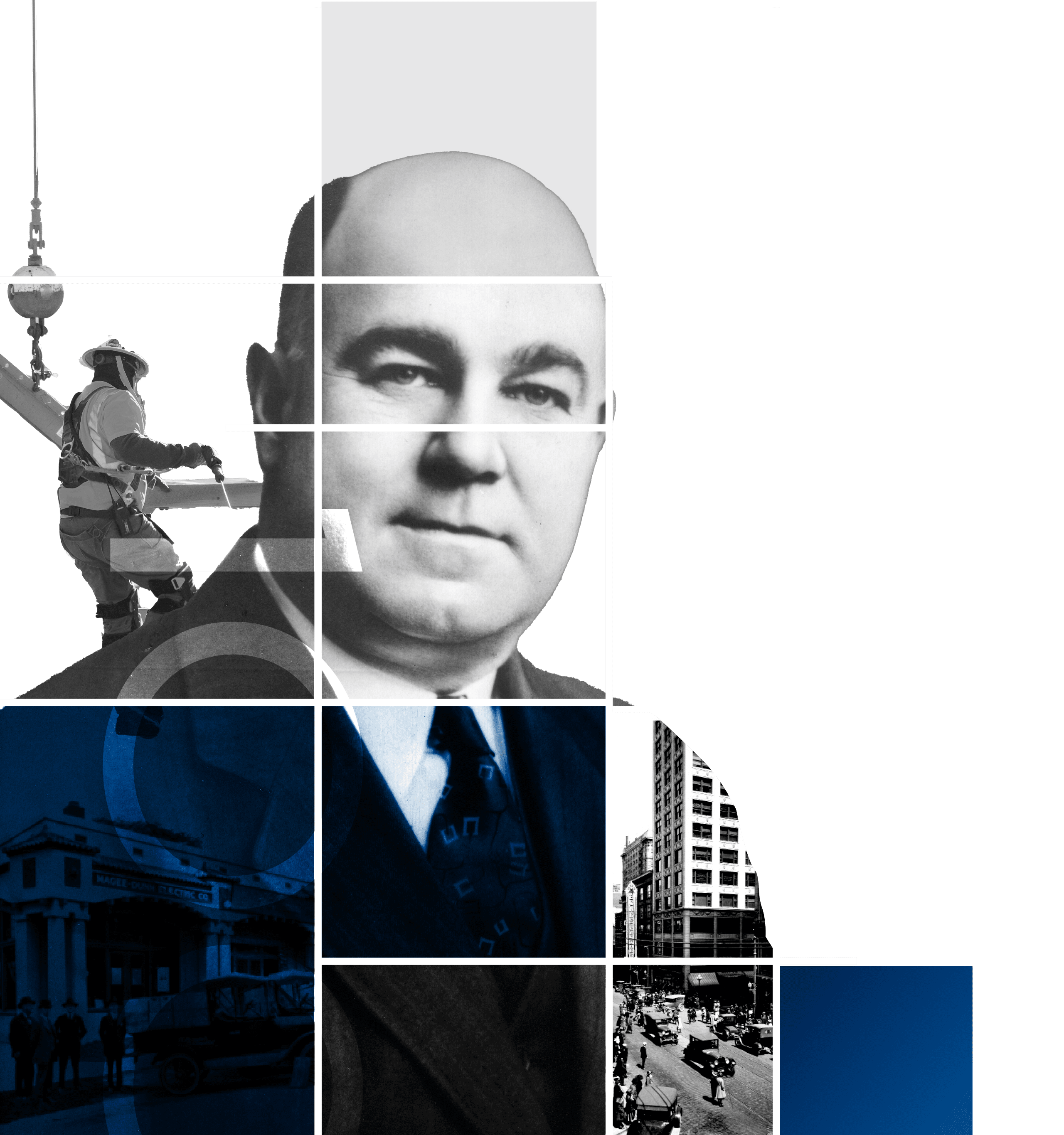Excavation, relocation, and new construction. Some projects are so large in scope that they require a unique approach and specialized coordination to complete. The new master plan for the Texas Capitol Complex is one of the largest and most ambitious projects in Austin, Texas. Phase I of the Capitol Complex includes a construction footprint of six city blocks, the construction of two new state office buildings, a five-story underground garage spanning three city blocks and a new central utility plant to support the business district, all by using a customized VDC approach.
The Capitol Complex Phase I was subdivided into six construction packages, JE Dunn was awarded three of the packages, each with complicated technical requirements. Our client, the Texas Facilities Commission (TFC), required comprehensive collaboration, innovation, and extreme VDC coordination to manage the six concurrent construction packages. Responsible for a 60-ft deep excavation (500,000 Cubic Yards) to support new office buildings; the utilities relocation of more than 10,000 linear feet of water, storm sewer, wastewater, electrical, and natural gas, chill waterlines and telecommunications equipment; and a new central utility plant (CUP) to tie into an existing plant, our team leveraged our in-house virtual design construction (VDC) expertise to create transformational solutions that ensured efficient, accurate execution of the massive, multi-phased plan.
A Customized VDC Plan
The first step in tackling the multi-phased project was to understand our client’s goals and outline the challenges that stood in the way of accomplishing them. Three separate packages (1EXC, 2UTL, 3CUP) came with their respective challenges, each requiring a tailored VDC solution. We leveraged specialized VDC software to align the different design components and compared each with trade partner models for all phases of this project. Specifically, we were able to coordinate the civil and building components to confirm they aligned and were not clashing. By ensuring alignment on the front end, we reduced potential risk to the schedule if conflicts were discovered and required rework.
“We expected the project teams to use building modeling technologies to support this massive project. What we didn’t expect was how valuable it was to coordinate the multiple trades working concurrently on this project. Sharing the models allowed all the teams to work out their schedules and design specific solutions more easily.” Keith Hall, TFC Project Manager.
Package 1: Excavation (1EXC)
Performing a 60-foot-deep excavation spanning multiple city blocks required a larger scale coordination plan than typical projects. We utilized laser scanning technology to confirm and demonstrate that the excavation walls were compliant with the project needs. The tolerance for walls covering such a large area is required to be within three inches (3”), so precision was imperative.
“We had to get the tolerance right the first time, as any rework would have been costly, especially on this scale of project,” said Superintendent Dave Muster. “To ensure accuracy on the tolerance for the walls, we as-built every other 5’ lift. Halfway through the dig on 1801 Congress, we did a VDC scan to verify we were on the right track. It was imperative we track our progress at regular intervals to ensure precision, avoiding any rework. Additionally, we used VDC to help us correctly position soil nails in our retention system to avoid new and existing utilities. This was an extremely successful approach that enabled the work to be done right the first time.”
Package 2: Utilities (2UTL)
On 2UTL, we created a comprehensive site model with the engineer to confirm the utilities were clash-free in all systems across the entire campus. Typically, we coordinate utility locations five feet outside of the building, but in this case, we coordinated the excavation of over 12 city blocks, requiring an unconventional approach to accommodate the scale of this project. All self-perform packages were as-built, allowing us to continually update the model in real time throughout the project and share with the owner, trade partners, design team, and engineer partners. This created a detailed, live map of what was underground, or not easily seen.
The city blocks we worked on are some of the oldest in Austin, and while we had information about the existing utilities, the information was not always reliable. This meant we would often find things we weren’t expecting when we dug for the new utility install. We had weekly meetings with the civil engineer to incorporate the revised information as well as the new utility install locations. This provided the owner with reliable information on the utilities not only for the current phase, but also for all future phases of work. To top it off, we did this work block by block to minimize impacts to the public.
Package 3: Central Utility Plant (3CUP) 3CUP required the construction of a new plant with tie-ins to the existing plant in a nearby building. Because of that, we leveraged VDC to create a comprehensive fabrication model to map the plant’s large complex systems. This model allowed us to plan at a detailed level how each system interacted with each other. For example, we were able to coordinate the location of the engineered suspension support systems with the piping it supported. Then we shared these precise points to the field team in preparation for the concrete pour.
“Coordination in the field using the model proved invaluable,” said Muster. “First, in the slab-on-grade phase, we as-built all the plumbing and electrical stub up’s before pouring, then we sent that off to compare to the model and found that more than half of the floor drains and clean out did not align with the contract documents. We were able to correct prior to concrete placement.
The fabrication model revealed that the piping systems were so large they needed to be engineered and placed in precise locations.
“When the suspension supports need to be engineered, this meant that we had to calculate the weight and location of every embedded hanger support. Generally, we do not need this on most projects, and we have much more flexibility. The engineered supports created a unique challenge on this project in that they needed to be precise. Our unique VDC approach allowed us to plan this precision, and achieve a smooth installation as a result,” said Muster.
The JE Dunn team coordinated all fabrication in the model, and when they laid it out in the field, we quickly determined adjustments needed to be made. Because we checked with the model so quickly (we measured the laid-out points, and checked that in the model), we were able to correct the issue and avoid a big problem down the road.
“The ability to pre-plan also meant that the installation of the CUP was like putting together a complex 3D puzzle in the field,” said Muster. “The accuracy of the model and collaboration with the team allowed us to consistently as-built items, leverage our VDC team to plot in the model, and verify everything had been installed correctly prior to placement of concrete. Over 1000 embeds were installed with exact precision and accuracy, making this an extremely successful process.”
Putting it All Together Though executed as three separate projects, the use of VDC to coordinate each project not only allowed for greater precision, but also ensured a seamless transition from one project to the next. Because we brought in the other vendor’s models to confirm tie-ins were aligned, we could certify they were accurate, and ensure each project would complement the others.
“To demonstrate this complexity, we had to run two large chiller pipes from the Central Plant (3CUP), out of the building around the site utilities (2UTL), under the 17th Street ramp (avoiding foundations) through the tie backs in the excavated wall (1EXC) and into the underground parking garage (another vendor’s project) to tie into the supply of the new buildings (Construction Package 4 & 5),” said Muster. “Using a collaborative VDC approach allowed us to break the phases down into manageable—and more importantly, accurate—segments.”
“The modeling for this project will serve TFC maintenance teams for generations to come”, Keith Hall, TFC Project Manager.
The precision provided by the VDC team ensured full transparency and a lean project from design to completion. Eliminating the need for an underground tunnel—and potential reworks—illustrates the unique application of VDC by our in-house experts that not only made a project on a massive scale more manageable, but also provided schedule certainty for the owner, the entire project, and all future phases of work for the TFC Capitol Complex.



